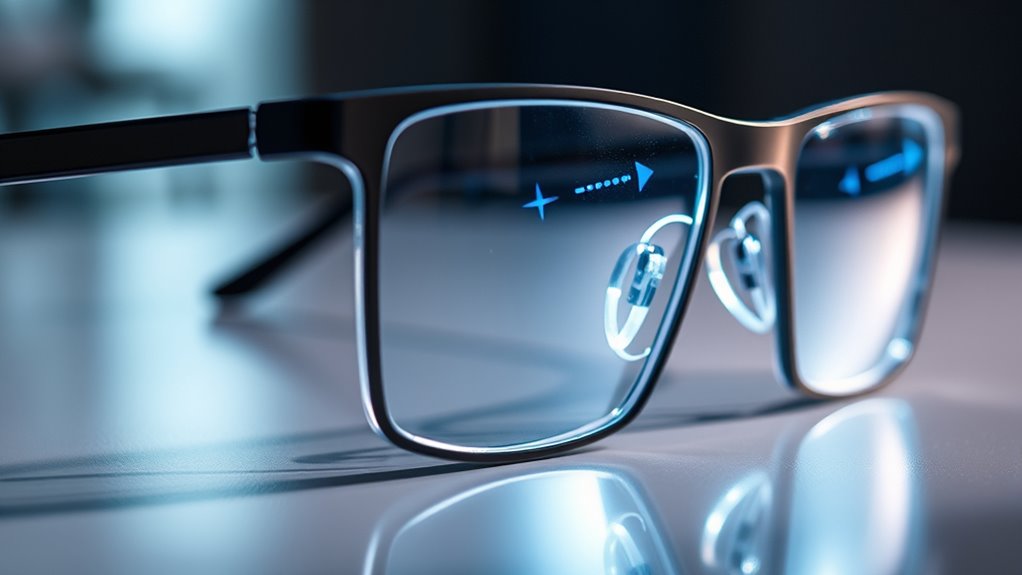Optical waveguides in smart glasses are tiny, transparent structures that guide digital images directly onto your real-world view. They use principles like total internal reflection to trap and direct light from the display, making overlays appear seamless and transparent. Different types, such as diffractive or geometric waveguides, help create clear, bright visuals without blocking your environment. If you want to discover how these sophisticated components work together to bring AR to life, keep exploring further.
Key Takeaways
- Optical waveguides in smart glasses direct virtual images onto the user’s view using total internal reflection.
- They are made from transparent materials like glass or plastic, maintaining environment transparency.
- Light is coupled into the waveguide at specific angles to ensure efficient guidance and minimal loss.
- Different types include geometric, diffracted, and diffractive waveguides, each offering unique benefits.
- Advances focus on reducing optical losses and improving image quality for more immersive AR experiences.

Smart glasses rely on optical waveguides to seamlessly overlay virtual images onto your real-world view. These tiny, highly polished glass or transparent plastic substrates are essential for guiding light from the display to your eyes while maintaining full transparency of your environment. When you wear smart glasses, the light carrying digital information is coupled into the waveguide at specific angles. Thanks to total internal reflection (TIR), this light bounces within the waveguide, effectively trapped inside, until it reaches the point where it exits toward your eye. TIR occurs when light hits the boundary between two media at an angle greater than a critical threshold, ensuring it reflects entirely inside the waveguide without leaking out. This principle is similar to how fiber optic cables transmit data over long distances, providing efficient and clear virtual overlays without obstructing your view of the real world. TIR’s effectiveness in guiding light makes it a fundamental principle in optical waveguide design for AR devices.
There are different types of optical waveguides used in smart glasses. Geometric waveguides employ mirrors and semi-reflective coatings to direct light, reflecting virtual images outward while letting the real-world scene pass through. These provide good image quality with minimal light loss but require complex manufacturing techniques. Diffracted waveguides, on the other hand, use surface relief gratings—tiny slanted structures on the waveguide’s surface—that diffract light via interference, guiding it efficiently through a compact, lightweight design. Some of these waveguides incorporate holograms or other diffractive elements for improved performance, allowing the virtual images to be brighter and more vivid without increasing the overall size of the device. Advances in materials and fabrication processes continue to enhance the performance and manufacturability of these waveguides, making them more accessible for consumer products.
Inside the waveguide, key components include the display engine—where the virtual images originate—and the optical lens structure that forms the waveguide itself. Light from the display is injected at precise angles to ensure TIR, then manipulated by diffraction gratings or semi-reflective mirrors to guide the virtual content into your eye. This setup must carefully balance transparency and brightness, so you see both the digital overlay sharply and the environment clearly. Efficient management of light minimizes optical losses, which is essential for conserving battery life and maintaining high-quality visuals. Advanced designs now feature gratings on both sides of the waveguide, expanding the field of view without adding bulk. Some newer models use multilayer gratings or holographic structures to improve image uniformity, color accuracy, and overall visual fidelity. These innovations, including advanced manufacturing techniques, aim to make smart glasses more immersive, compact, and cost-effective, pushing the boundaries of augmented reality technology.
Frequently Asked Questions
How Durable Are Optical Waveguides in Everyday Use?
You might wonder how durable optical waveguides are in daily life. They’re designed to withstand regular handling, impacts, and environmental factors like humidity and temperature changes. Precision manufacturing, high-quality coatings, and strict quality control help maintain their performance over time. While surface imperfections and wear can affect them, proper design and maintenance guarantee they stay reliable, providing consistent optical quality even after extended use.
Can Optical Waveguides Be Customized for Different Visual Needs?
You can customize optical waveguides to fit your specific visual needs. They can incorporate your prescription lenses seamlessly, maintaining your natural vision while adding AR features. You have options to tweak the waveguide’s design, such as grating structures, coatings, and dimensions, ensuring ideal image quality, transparency, and comfort. This customization allows your smart glasses to adapt to your unique eyesight, providing a personalized, enhanced visual experience.
What Are the Limitations of Current Optical Waveguide Technology?
You might think optical waveguides are ready for widespread use, but they still face significant limitations. Manufacturing is complex and costly, making mass production difficult. Their efficiency drops in bright environments, and image quality suffers from artifacts and inconsistencies. Plus, designing slim, stylish glasses remains challenging due to bulk and shape constraints. These issues hinder durability, comfort, and affordability, slowing down the development of truly practical and consumer-friendly smart glasses.
How Do Optical Waveguides Affect Battery Life in Smart Glasses?
Optical waveguides impact your smart glasses’ battery life by increasing power consumption, especially with high-resolution, bright displays and active AR features. You might notice shorter usage times, like just a couple of hours, unless the device uses low-power microLEDs or efficient components. To extend battery life, manufacturers offer larger or external batteries, hot-swappable options, and power management tech, balancing visual quality with longer, more portable use.
Are Optical Waveguides Environmentally Sustainable?
You might wonder if optical waveguides are eco-friendly. They can be sustainable when designed with low-impact materials, efficient manufacturing, and recycling efforts, which reduce waste and resource use. Using durable, long-lasting waveguides minimizes replacements, cutting down on environmental impact. Additionally, innovations like biodegradable and integrated waveguides further enhance sustainability. By choosing eco-conscious designs, you help promote greener technology and lessen the environmental footprint of optical systems.
Conclusion
Think of optical waveguides as the veins of your smart glasses, carrying essential information straight to your eyes. They’re the unseen heroes that make the digital world seamlessly blend with reality, like a gentle river guiding water effortlessly to its destination. As you wear your smart glasses, remember this delicate yet powerful network working behind the scenes—connecting, illuminating, and transforming your view of the world. It’s technology’s quiet magic, making every moment sharper and more connected.









